
Anthony Sonnenberg, Reliquary for Miss Kitty, 2018. Porcelain over stoneware, found ceramic tchotchkes, under glaze, glaze, gold luster, feline cremated remains.
19 x 19 x 12 inches
Brandon Zech: We’ve been talking about doing this conversation for a long time and I’m glad we’re finally getting down to it. You and I have both noticed, over the past few years, how prevalent ceramics have become in contemporary art. Of course, artists have never stopped making ceramics — and we have great institutions in Texas like the Houston Center for Contemporary Craft that remind us of this — but it does seem like until recently ceramics weren’t “in.” Now, you can’t go to a gallery without seeing ceramic works, be it in the main exhibition or in the back room. So, Christina, just what is it that makes today’s ceramics so different, so appealing? (This may sound smug, but I really like this as a title for our conversation and I think we should keep it.)
Christina Rees: I like your title, too. Richard Hamilton is an interesting reference given he was a painter and collage guy and as far as I know never touched clay. 😉
I noticed the ceramic and clay explosion earlier than you did, but later than those who’ve been watching this for more than, say, a decade — or four. When I was the curator at Fort Worth Contemporary Arts, in 2012 I had the artist Margaret Meehan guest curate a group clay show for us. She titled it under the table, and it was a major learning curve for me, but one thing that Meehan has been very good at acknowledging over time is the fraught reputation clay has in the art world. Various art worlds. The title of the show referenced Mike Kelley and Paul McCarthy’s video Heidi (1992), and Meehan wrote: “The show starts from the understanding that on the table is kitsch and under the table references perversion.” The artists in that show are good. All of them. The work was exciting to be around. Nine national and international artists were in that show, including Kate Gilmore and Mathew McConnell and Thomas Müller and Akio Takamori. Kristen Morgin.
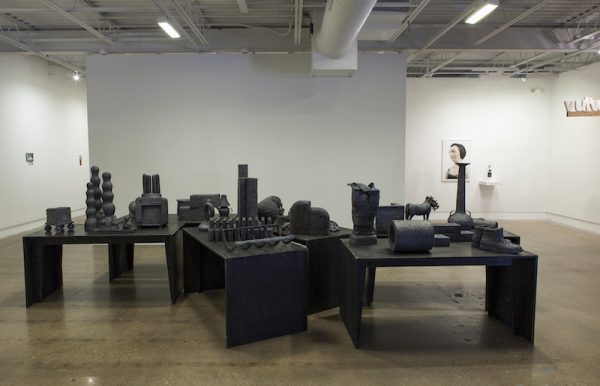
Installation view of ‘under the table’ at FWCA in 2012; foreground: Mathew McConnell’s Many Things New and More of the Same, 2010
At the same time, I was paying attention to TCU’s main clay professor whose work I love: Chris Powell. As well as some of his ongoing collaborations he was doing with clay artists in Japan. That combo of long tradition bound to a new idea is compelling to those of us who are always looking around and asking ourselves what art actually is. But gosh yes, artists can and do make actual art from clay, and clay-adjacent material, and they do very non-clay things with clay and present it in non-traditional ways that I’ve never seen — and the good stuff can be so good it can make my eyes water.
But I think the most recent explosion of clay and ceramics’ popularity is probably down to a few specific factors. One is novelty. In this moment, we need “new” all the time, and “more,” and clay just adds something different to the mix of artist materials we’re already so accustomed to seeing.
Two: that shit photographs like a dream, and photos (especially via social media) are how people are selling work most efficiently at the moment (and by “selling” I don’t just mean selling for money, I mean “communicating the whole shebang in a photo,” whether the work is in a museum or gallery or private collection). That’s just not true of a lot of other forms of art. It’s a continuation of sculpture’s unfair photographic advantage over much two-dimensional work. That three-dimensional, corporeal quality, and tactile presence of clay, makes you think you can feel it through your screen — it’s practically an anthropomorphized thing you could shake hands with. I’m thinking about Arlene Shechet, or Anthony Sonnenberg. C’mon! So juicy.
What else? Why do you think it’s even more popular now?
BZ: I definitely agree with your point about novelty. I feel like over the past few years, particularly since 2016, I’ve seen a younger, early-to-mid-career artists adopting clay as a medium. Of course, by now, all modes of art making are very well tilled — but at the same time, although its history is ancient (looking at you, black- and red-figure vases), I think for many artists clay still seems like an untouched medium.
Part of this, I think, is based on scarcity of materials: paintings, and many sculptures, can be made at home or in one’s studio. But with ceramics, you have to have access to a kiln if you’re doing anything complex. With this in mind, some of the most popular ceramics, the ones that can really sell themselves, are the ones that are unusual forms coated in gobs of glaze — pieces that require multiple firings. It’s not uncommon to see an artist who hasn’t touched clay before suddenly come out with a batch of goopy, semi-functional sculptures just because their month-long residency had a kiln in-house.
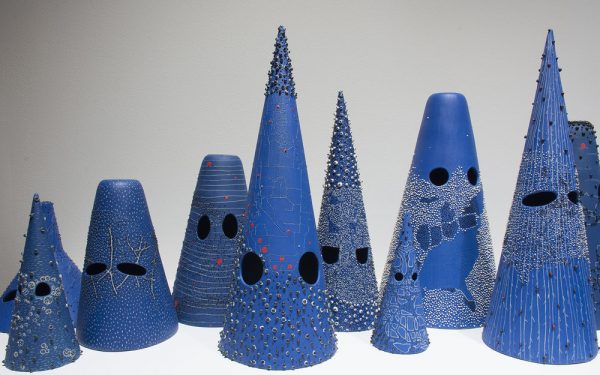
Tammie Rubin, Always & Forever (forever ever ever) No. 2, Slipcast & handbuilt porcelain, underglaze, pigmented clay
Ceramics are also so popular because they’re mysterious. Most of the time when you’re looking at a painting, even if you’re not a painter, you can tell how the artist created the image on the canvas. It’s paint — you can look at the mixing of colors, the application, etc., and we can all understand the use of a brush or palette knife. Contrastingly, we have no ground to stand on when it comes to the chemistry behind various glazes. Some artists I’ve talked to who make ceramics have said that the best ceramicists they know are basically chemists. The chemical makeup of glazes, and the effects they have when fired, are oftentimes what we love most about ceramics; it’s what gives the pieces a photographic tactility. And most of the people involved in the art world couldn’t explain how artists get these effects. Somehow, I think the ceramics-making process might be even more convoluted and unexplainable than the various printmaking processes.
I also get what you’re saying about social media, but at the same time, one artist I talked to who is now making ceramics said that they thought the handmade, ‘personalness’ of the medium is somewhat of a backlash against our mass-produced, detached art world. What do you think about that?
CR: I can tell you’re not a painter. Especially an oil painter. I mean that what goes into making a John Currin painting goes so far beyond the fact that the guy “can paint.” It took him years to get the effect he wants. The learning and exploring of material use never stops for an evolving painter, or any artist who sticks with specific materials for the long haul.
But, yes: here is where we belatedly acknowledge the variations on clay and why the conversation comes back to ceramics in particular, for much of our purpose here. That’s why I name-checked Sonnonberg and Shechet toward the end of my last bit, and didn’t come back to McCarthy and Kelly’s Heidi.
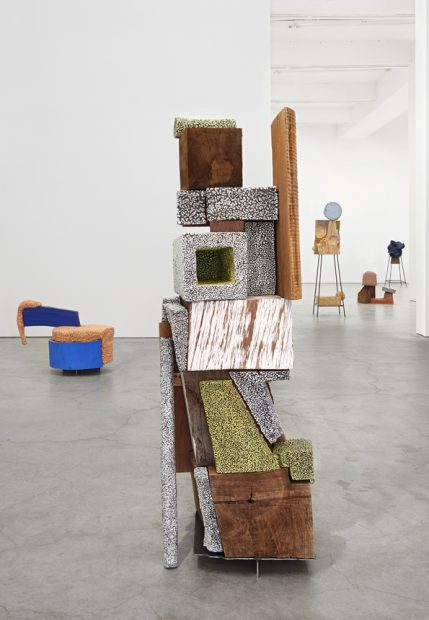
Installation view of Arlene Shechet’s exhibition Turn Up the Bass at Sikkema Jenkins & Co, NYC, 2016
But I don’t want to talk about functional, decorative ceramics, aka pottery. I drink my coffee everyday from beautiful ceramics I’ve brought home from all over, but that ain’t art. It’s history, and beauty, and satisfying to the touch. Function itself is a kind of beauty. But it’s not automatically art by any stretch, not when we’re on the topic of contemporary art in the western world — not post-Duchamp. Obviously, some artists make both things. Awesome useful things, and also art. Craftspeople and artisans don’t make both. They dedicate themselves to a tradition and process, where material is king and expectation is bound. The tweaks can be inventive and surprising and personal, but they don’t transcend the point of the material.
But on your latter note: Yes! Totally agree. I think people come back to looking at historical craft materials as potential art-making materials when about three things are in the air:
One, political and economic instability — a feeling of not being safe — gets artists back to the hearth, as it were. There’s a coziness and familiarity in what we call ‘the domestic arts’ that calls to us when we’re scared, and a lot of us are pretty scared of the present and the future these days. I think the surge of clay-based art during this century so far was somewhat set off by 9/11, and now we have Trump. Generally I just I see returns to the grounded materials of wood, textile, clay, etc, for some artists.
Two, it requires experience, which speaks directly to your former point about the value we want to place on expertise. More and more people are battling “everythingness” with specificity, and I mean earned specificity. It’s street cred to be very good at something that others can’t just go home and do right away. I’d liken it to the flood of craft brewers and nose-to-tail chefs and cheese makers. But again, this is dangerous territory. We’re making our way back to craft.
Third, artists are explorers. They have fun messing with expectation. They subvert it. Ceramic has specific connotations and rules, and artists smash them. Gleefully. It’s what they do, and right now, ceramics are trending in that department.
Ceramic in particular as art is still on an upswing, as a subcategory of clay as art. But the bottom line is anything can be an art material in the hands of an artist. Mayonnaise. Paper. Chalk. Ceramic is a clay process. It’s what you do with it that makes it break toward either “art” or “craft.” Who are you looking at that comes to mind?
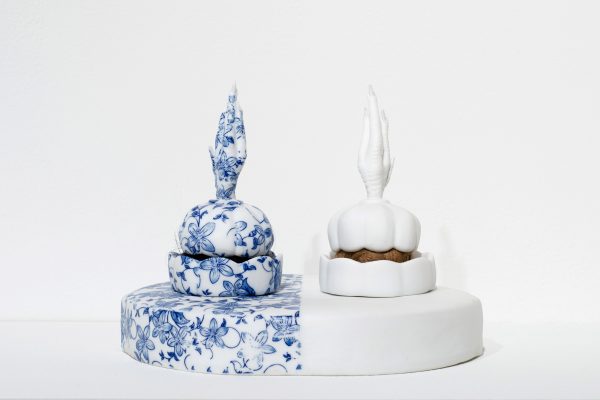
Jennifer Ling Datchuk, Half, 2016, Jingdezhen Chinese porcelain, blue and white transfer pattern, collected hair
BZ: There are a whole host of Texas-based artists who have been making ceramic works for a long time: Austin artist Scott Proctor, who established the East Side Pot Shop in 2017; Houston artists Jeff Forster, Jessica Kreutter and Angel Oloshove; San Antonio artists Jennifer Ling Datchuk and Diana Kersey; and Austin artist Tammie Rubin are just a few that immediately pop into my mind. As for artists working outside of Texas, I feel like Francesca DiMattio has continued to do great work; Annabeth Rosen has received a lot of attention (she also recently had a solo show at the Contemporary Arts Museum Houston); I’ve always thought Joakim Ojanen’s pieces were just plain weird; and Cary Leibowitz’s pithy, glaze-your-own, pottery-shop ceramics are fun. (Leibowitz also had a show at CAMH recently — see, they’re even invading our institutions!) Of course, this is just a cursory list.
One harbinger of the ceramics apocalypse for me was the CLAY TODAY group show at The Hole, a for-profit gallery located just down the street from the New Museum in New York. The space and its owner, Kathy Grayson, are always teetering on a ledge between obscurity and mainstream popularity — meaning that they always find artists either right before, or right after they “blow up” in the New York art world.
With that said, I was surprised that The Hole’s clay-themed exhibition didn’t come at least a year sooner. I suppose if it had, it also would’ve been a completely different show, being as so many of the works were either made in 2017 or 2018. I’d also be remiss to not mention that Site 131 in Dallas recently hosted a clay-themed show titled CLAY + Things, and that the San Angelo Museum of Fine Arts hosts a biennial national ceramics competition exhibition. I’ll stop naming clay-themed shows now, because if I went on, we’d be here all day.
On your idea of coziness and familiarity, I could get why political or personal turmoil might inspire an artist to do more than take a brush to a canvas. Physically making something — literally shaping something with your two hands — is a different kind of gesture. Maybe this is me projecting, but I think it makes you feel like you actually have real control over something. And oftentimes that comes out in the bodily-ness of the thing that is made, too. Are you looking at anyone different than the people I named?
CR: You know I’m a fan of Dallas-based Brian Molanphy, at SMU, though he’s international. And I’ve seen his work more often more recently, including in the Site 131 show, and his solo exhibition at the San Angelo Museum of Fine Arts in the spring of 2017. I’ve noticed that a mutual art friend of ours, Melinda Laszczynski, is very recently tearing it up with the experimentation in glaze and lusters! It love it.
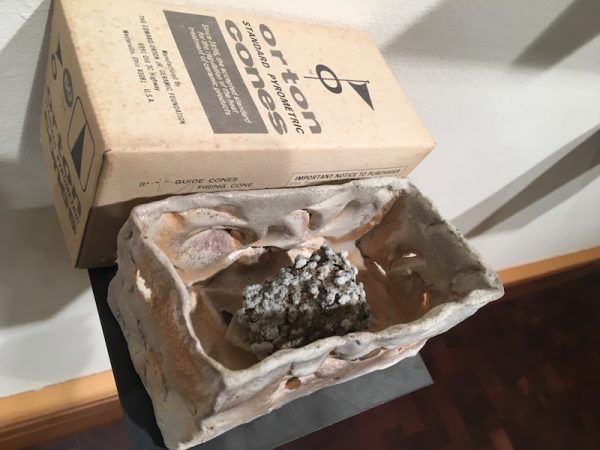
Detail: One of Brian Molanphy’s ‘wasp nest’ works — this photo was taken at the San Angelo show in 2017
There’s the thing where an artist isn’t a ceramic or clay artist to begin with but, if they’re primarily conceptual, will give a shot to clay or even the rigors of the ceramic process. I haven’t spoken to anyone who wasn’t taken with Shelby David Meier’s cast take-out food cartons, also in the Site 131 show. They’re great. And I really don’t want Meier to be a clay artist. I just like that it’s on his menu of materials.
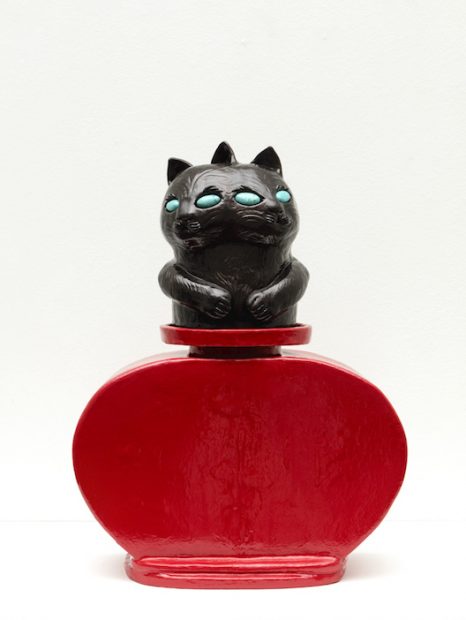
Celia Eberle, Love Me Two Times, 2015. Ceramic, acrylic, howlite, 18 x 13.5 x 7.5 inches. Courtesy Cris Worley Fine Arts, Dallas
Celia Eberle is a veteran badass in Texas — a pure conceptual artist who makes the materials sing in service to her ideas. I live with her work. I wake up to it. I can’t get enough of it, though I can’t afford it. Clay is truly elemental, and has been part of human existence and survival for thousands of years. The functional aspect of the material has, of course. The art part (in the modern Western world) is far newer, but becoming part of our understanding of the scope of the material. I hope so. I drink from a ’70s Villeroy & Boch mug (Acapulco is the pattern; I grew up with it), or a mug I bought from the student ceramic campus sale at UNT. Etc. And then I look up from my laptop and see art by Chris Powell and Celia Eberle and Margaret Meehan in my living room. That appealing ‘object-ness’ you refer to — we crave it, don’t we?
And that’s regardless of how unstable or stable the times are.
I think some potential collectors can make a smooth entry into art collecting with clay (and works on paper of course; please look into drawing and prints!), given that more young artists are going to town with the material and doing interesting things. But good ceramic-process art (if I may) doesn’t come easily, and the good work, I think, shouldn’t be at all cheap.
I love your point about the addition of kilns (or more kilns) at art residencies and schools. Do you remember the tour we took of Texas Tech’s ceramics department a couple of years ago, up in Lubbock? Do you remember all those freaking kilns?! Inside and out. That in itself was like a wonderful study in wretched excess. (Go, Texas? Go, Texas wealth.) I mean that in the best way. How could you be an art student there and not wanna try to fire something at some point, even if your main thing is painting or metalwork or photography?
BZ: Yes, exactly. The kilns at TTU are insane. Then again, that entire new art building is a study in wretched excess, so the kilns are just over-the-top as a sort of by-product. But we digress.
People love the objectness. And ceramics generally transcend the “I want to touch it but I can’t because it’s art” boundary because they are ceramic. If you touch one of Donald Moffett’s wispy oil paintings, you could destroy it, but if you want to touch one of Laszczynski’s ceramics, go ahead, because unless you drop it on the ground, you’re more or less good. This tactile, you-can-touch-it, sometimes-functional quality is really important to some artists who make ceramics.
For example, when we talked about Nick Weddell’s amazing cups, and I mentioned that I thought some of the glazes he uses might be lead-based so I wasn’t sure if the pieces were actually functional, he reached out and emphasized to me that the pieces’ functionality was essential to their existence in the world. Of course I’m probably never going to drink anything out of one of his impastoed mugs (he even used the term “daily drinker” to describe pieces that could take more wear and tear, including different kinds of drinks that wouldn’t get sugar or other particles stuck in the nooks and crannies in the pieces), but the important idea is that if I wanted to, I could.
I also agree about people like Eberle and Meier — some of the best artists making ceramics aren’t “ceramics artists” — they’re just artists who really know how to use materials to their advantage. I’ve always believed that the best artists let their materials do 75% of the work for them.
For collecting, I think one reason for the ceramics boom is that good ceramics can be relatively cheap to make, and therefore affordable to buy. Quite a few artists who make ceramics are regulars at markets and fairs around Houston; Jessica Ninci particularly comes to mind. Her pieces — some functional and some sculptural — have a laid-back coolness and simplicity of form that is universally appealing. I enjoy seeing her sculptural works laid out on a table just as much as I enjoy seeing paintings on the wall of a gallery. Of course people like Ninci do have gallery shows — and those are great too — but I think our willingness to engage with ceramic pieces in alternative settings really sets the medium apart from other art forms. Would you agree? The fact that you have a cup from a UNT student sale would make me think you might have some ideas.
CR: I’m glad you mentioned the fact that ceramics are physically tough. They are. The process is about toughening the material so it’s usable. The glazes and such are more often aesthetic (certainly for artists). Though I wouldn’t walk into a gallery and touch a Ken Price piece unless the gallerist gave me a pass.
The problem with that familiarity, and the upside of it, oddly, is that yeah: We humans have a pretty established sense of ceramics being something to handle and use, or to be enjoyed as decorative objects, which can go very kitsch or sentimental very quickly. (And you know I’m a sucker for ceramic animals, old and new — kitsch be damned.) Artists generally wink at the kitsch, and make it work for them, or they deep dive straight into it, unironically, which in itself is a type of context/content perversion.
But that upside: When you see that an artwork has been made with that process, it’s easy to get the first impression that it’s not art. Which is what makes the perversion of it interesting, for artists and for viewers. That’s what many of these artists are doing, as Meehan wrote in her curator statement: they are subverting or perverting our sense of what ‘ceramic’ is or means (though she was referring to clay overall). Sometimes in an absurdly excessive way. That’s the trend I’m seeing most now. Look at this thing I made and how fucking wrong and crazy and undefinable it is!
I do fear an overabundance of this.
BZ: Isn’t that just a sign of the trends within the art world and what’s hot right now, though? I agree it seems like the overabundance of ceramics — particularly over-glazed, bulbous forms — has a Godzilla-running-amuck-in-the-city feel right now. Brad Troemel, an artist who makes memes that oftentimes poke fun at the absurd aspects of art, even had a “goopy ceramics vs. gradient painting” Instagram story count going at Frieze New York in 2018. It’s crazy how in the zeitgeist ceramics are right now, which coincidentally is why this conversation is happening. I feel like, if anything, we’re late to the party.
One interesting thing about the popularity of ceramics though is that I feel like Texas sometimes dodges popular art trends. Like the super-hip, post-internet painting style that really was only around in Texas because certain galleries, like Circuit12 Contemporary, brought it here from the outside. The ceramics movement, somehow, has penetrated our state lines. Why do you think that is?
Of course I know that Texas artists aren’t blind to the market or the larger art world, but a lot of times most of Texas simply doesn’t care. Back to TTU’s ginormous kilns: something that comes to mind is abundance and space — two qualities that aid in ceramics and ceramic making.
CR: I get your point: there’s an excellent ‘opt-out,’ maverick sensibility that pervades the Texas art scene. It’s one of the things that seduces you and me and keeps us in the state. But I think where really recognizable trends are concerned, like this one, the artists here are like artists everywhere. They want the work out there. They want it to be seen, and to sell. This is gallery art. Museum art. Or that’s the idea.
But I would guess that in the art schools in Texas, the clay students are looking at the same contemporary artists that the students in art schools all over the US and beyond are looking at: Jeffry Mitchell, Lynda Benglis, Sterling Ruby, Allison Schulnik, Grayson Perry… . (That list even is a bit dated, isn’t it?) Frankly, I think the Texas artists making clay or ceramic work aren’t any more or less chasing the market than artists from anywhere else.
What I think we’ve primarily not parsed here is the more historical and international legacy of artists using clay — in Japan, in China, in the Middle East, in the Americas — and how that’s influenced current clay and ceramic artists. This subject can go about as deep as one wants it to go, and the philosophical or intellectual arguments about what constitutes art versus design versus decoration versus useful function morphs as you move through geography and history.
We’re at the tip of an iceberg here, in that respect.
What we’ll see here in Texas, I think, is artists who’ll experiment with ceramic, and make a body or a few bodies of work with that process, and then tire of its limitations — and we’ll see artists who are almost obsessed with its limitations and want to challenge that and keep pushing. I’m looking forward to watching this play out. What do you predict for this trend?
BZ: In regards to the history of ceramics, especially in non-Western traditions, you’ve hit it on the nose. Anyone who cares enough about art, ceramics, and/or ceramic art to read to this point will undoubtedly realized there are drastic parts of this conversation (and this medium) that we’ve barely touched. At the same time, these influences are everywhere if we look close enough, in many of the artists whose names we have mentioned, and in countless others.
In terms of where the ceramics trend goes from here, I more or less agree with what you said — although that might be a bit of a cop-out because your statement covers more or less anything that’ll happen in the coming years. So I’ll make a longer-term prediction: I think the younger generation of artists who have really taken a liking to ceramics might continually go back to the medium, and over time, as they attend more residencies with kilns, work at institutions with ceramic studios, and maybe even buy kilns themselves, we’ll have a robust community of late-career artists who are prolific in myriad media, because that’s where art making is going anyway.


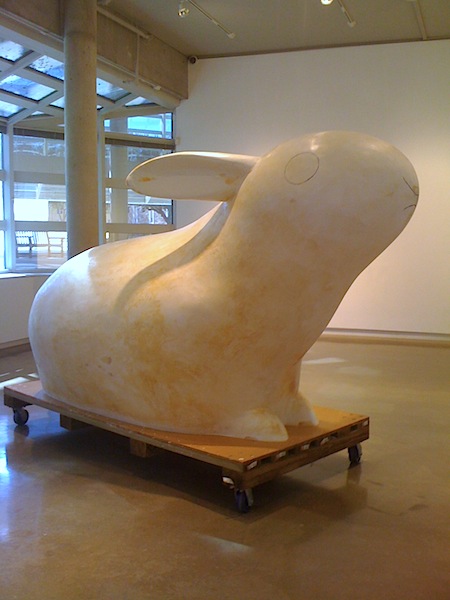
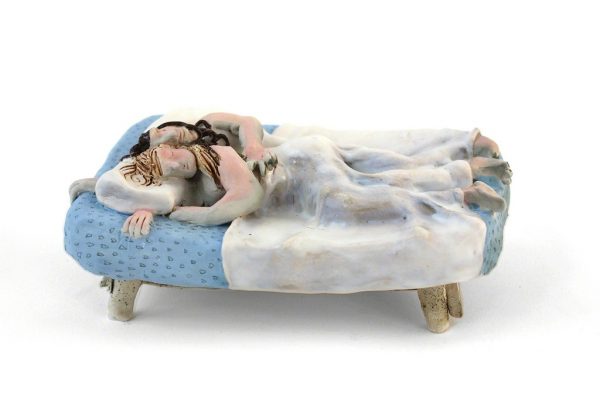


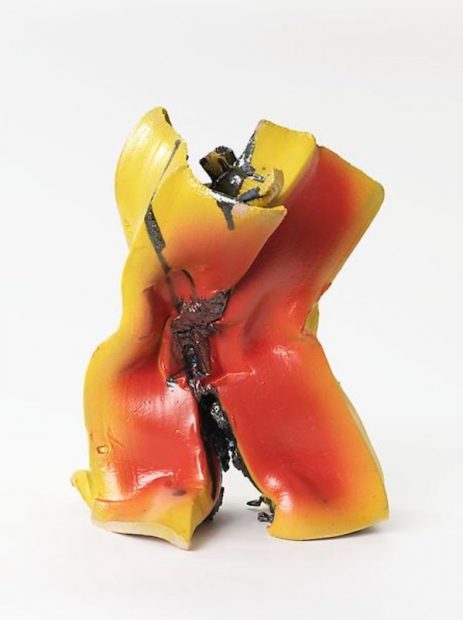
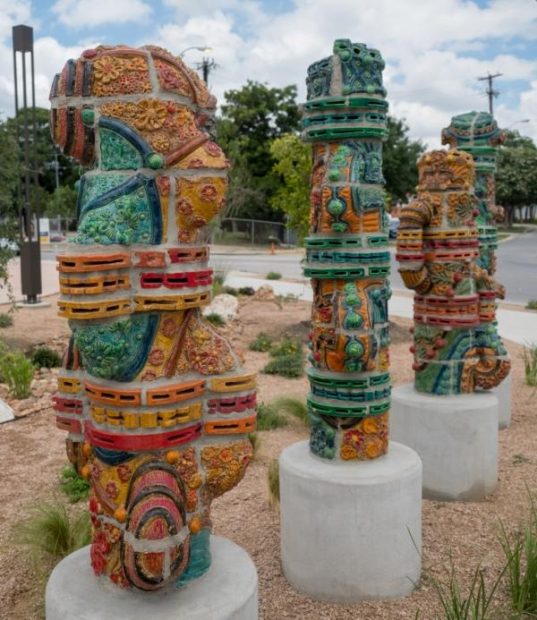

8 comments
Great article, so happy seeing one dedicated to ceramic work. Clay has been floating in the background too long. I started collecting clay (Paul Soldner, etc) in the 70’s, curated an exhibition of Grayson Perry’s in 1990 and since they quickly went past my budget I am now collecting young artists including Ahryun Lee and Jongjin Park.
Clay is a great way to introduce children to art that they can make the visual come alive with touch.
Good question. Actually I see a lot of appropriation of ideas and variations on forms from the eighties. Definitely less chemistry and more use of commercially prepared underglazes, glazes, decals and lustres. And big kilns sometimes just means bigger bad ideas. Just happy that organizations like Clay Houston have survived and carry on the local push for education and exhibition opportunities that we started in the seventies.
How did I even find this article? What a gem! A treasure trove of ideas and actual knowledge. Thank you for delving in.
If you love great ceramic sculptural works don’t miss Texas artist Susan Budge’s Objects of Affection, opening January 19 at Heidi Vaughan Fine Art in Houston. Susan has been working in clay for 40 years. Her objects can be found in museum collections across Texas and throughout the US. She currently teaches at the MFAH’s Glassell School and Art League Houston. PS I’m curious about that Heidi video. I’ll have to look into that!
These conversations are rich with ideas and observations. They teach what we should be sharing with students about visual art, about how to look/read/see objects. Please continue these conversations. Though making art less intensely, the Glasstire dialogs remind me of what I tried to teach and learn from my students and colleagues. Thank you Christina and Brandon. This was so enjoyable.
As Heidi noted above, Susan Budge has been very influential in Texas as well.
Ceramic artist Helena Gijsbers Van Wijk does excellent work as well.
The recent conversation “Just What is it that makes today’s ceramics so different, so appealing?” addressed the subject of clay/ceramics as fine art with an open eye of appreciation, it is unfortunate that both Brandon and Christine are so young that their experience is limited to a 2012 personal experience and an appreciation of TCU’s Chris Powell. Jeff Forster, Jessica Kreutzer and Angel Oloshove of Houston did get a mention as having been making ceramic works for a long time; excuse me. As much as I love all their work, Jo Zider’s “Kabuki Forms” was featured in Ceramics Monthly in 1986! Sue Carr ran a Fine Crafts Gallery in Houston, in the 80’s featuring the tradition breakers Tracye Wear and Eileen Montgomery. What’s really new is not the globby glaze stuff, but Jeff Forster and Michelle Mathews “raw” unfired clay forms that have more to do with the pure nature of the material. Clay is a phenomenal material that has so much potential for artistic expression; we are just scratching the surface. And by the way, my own “Clay Transformation Project” started in 1990 in west Texas is about to reach a thirtieth anniversary.